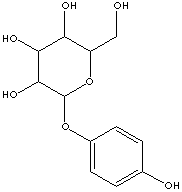| CAS
NO. |
497-76-7 |

|
| EINECS
NO. |
207-850-3 |
| FORMULA |
C12H16O7 |
| MOL
WT. |
272.25 |
|
H.S.
CODE
|
2938.90 |
|
CLASSIFICATION
|
|
|
SMILES |
|
|
TOXICITY
|
|
| SYNONYMS |
4-Hydroxyphenyl-D-glucopyranoside;
|
| Hydroquinone beta-D-glucopyranoside;
|
|
PHYSICAL AND CHEMICAL PROPERTIES
|
| PHYSICAL
STATE |
white
powder, odourless |
| MELTING POINT |
199
- 201 C |
| BOILING
POINT |
Decomposs |
| SPECIFIC GRAVITY |
|
| SOLUBILITY
IN WATER |
soluble |
| pH |
6.0
- 7.0 (1% sol.) |
| VAPOR DENSITY |
|
|
AUTOIGNITION
|
|
|
NFPA
RATINGS
|
|
|
REFRACTIVE
INDEX
|
|
| FLASH
POINT |
|
| STABILITY |
Stable
under ordinary conditions |
|
APPLICATIONS
|
|
Arbutin, a glycosylated hydroquinone, acts as an antiseptic agent or
antibacterial agent on the urinary mucous membranes while converting into
hydroquinone in the kidney. It is also used as a depigmenting agent (skin
whitening agent) as it
inhibits melanin synthesis by inhibition of tyrosinase activity. |
| SALES
SPECIFICATION |
|
APPEARANCE
|
white
powder |
|
ASSAY |
99.0%
min |
|
SPECIFIC ROTATION |
-63°
~ -66° |
|
HEAVY
METALS |
20ppm
max
|
|
HYDROQUINONE
|
nil
|
|
MELTING
POINT
|
199
- 201 C |
| TRANSPORTATION |
| PACKING |
|
| HAZARD CLASS |
Not
regulated |
| UN
NO. |
|
| OTHER
INFORMATION |
|
|
